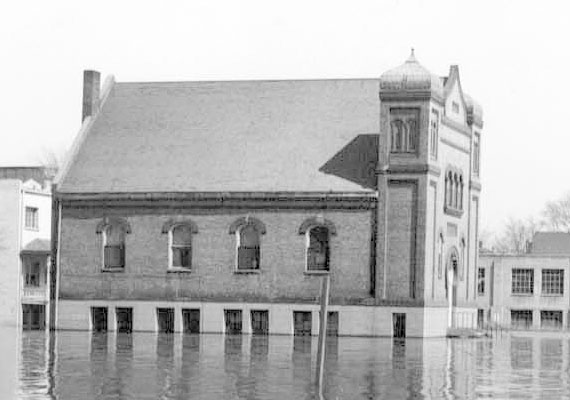Fargo Hebrew Congregation

In 1891, an Orthodox rabbi in Fargo commented that it was challenging to gather a minyan, 10 Jewish males over the age of 13 required for prayer services in Orthodox Judaism. In 1896, a charter was granted to William Gilles, Abraham Rubel and David Mezirow as the incorporators of the Fargo Hebrew Congregation. Members held services in their homes until the congregation could begin building its 350-seat synagogue on First Avenue South and Fifth Street in 1904. It faced Island Park and is pictured above (during a flood in the 1940's). The building committee was Sam Paper, S. Epstein, M. Seigel, M. Levitz, P. Hartstein, J.M. Hartstein, A. Yoffe, A. Rubel, I. Schwartz and A. Weiser. The synagogue opened in 1906.
More than a worship hall, the synagogue also served as a social center for the Jewish residents of Fargo until World War II. In 1901, the Fargo Hebrew Ladies Society was founded. It organized social gatherings and raises money for the synagogue and charities. The blocks immediately surrounding the synagogue – along what is now Main Street from the bridge to where Community First Bankshares now sits – were often referred to as the Jewish ghetto, according to Sam Geller, Mike Geller’s father, who was interviewed in the mid-1980s by Linda Mack Schloff, a Jewish historian. Sam Geller, who started Geller’s Auto Parts with his father, died in 1990. In this neighborhood, many businesses were run by Jewish families. Two women ran a grocery store with the “largest selection of penny candy one ever hoped to see in a life time,” Geller told Schloff. Alex Cash owned a pool hall. Abe Siegel and Emil Weingarten operated clothing stores.
Following the end of World War II, a split occurred in the Fargo Hebrew Congregation. Forty-nine families, about half the synagogue’s membership, left to form Temple Beth El, a Reform congregation. With this drastic decline in membership, the Orthodox congregation could no longer support a full-time religious leader. Laymen conducted weekly services and rabbis led services on the holidays.
In 1954, a fire severely damaged the synagogue. Temple Beth El offered space for the congregation to conduct its Sabbath services. Eventually the building was sold to Fargo-Moorhead Trades and Labor Assembly and later demolished. Despite its declining numbers, Fargo Hebrew Congregation decided to build a new synagogue in 1955. The altar and pews from the original buildings were brought over to the new one at 901 9th St. S. It could hold 175 members. Rabbis from neighboring communities like the Twin Cities held high holiday services – Rosh Hashanah and Yom Kippur – each year.
The synagogue stopped holding regular weekly services in 1990. The last high holiday services were in 1999. The rabbi who had been conducting them took a part-time job with a synagogue in the Twin Cities and needed to lead services there. It became more and more difficult to get a minyan.
Members called it a painful decision, but in the spring of 2002 they auctioned off the building and the items inside. The building was bought by an individual with ties to a local evangelical church, which may lease it for a Wednesday night children’s program and adult Sunday school.
The Fargo Hebrew Congregation was the last Orthodox Jewish synagogue in the Dakotas.
The information on this page was derived from an article by Erin Hemme Froslie in the June 23, 2002 Fargo Forum.
